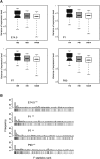Copy number variation modifies expression time courses
- PMID: 21084671
- PMCID: PMC3012917
- DOI: 10.1101/gr.112748.110
Copy number variation modifies expression time courses
Abstract
A preliminary understanding into the phenotypic effect of DNA segment copy number variation (CNV) is emerging. These rearrangements were demonstrated to influence, in a somewhat dose-dependent manner, the expression of genes that map within them. They were also shown to modify the expression of genes located on their flanks and sometimes those at a great distance from their boundary. Here we demonstrate, by monitoring these effects at multiple life stages, that these controls over expression are effective throughout mouse development. Similarly, we observe that the more specific spatial expression patterns of CNV genes are maintained through life. However, we find that some brain-expressed genes mapping within CNVs appear to be under compensatory loops only at specific time points, indicating that the effect of CNVs on these genes is modulated during development. Notably, we also observe that CNV genes are significantly enriched within transcripts that show variable time courses of expression between strains. Thus, modifying the copy number of a gene may potentially alter not only its expression level, but also the timing of its expression.
Figures




References
Publication types
MeSH terms
Associated data
- Actions
LinkOut - more resources
Full Text Sources
Molecular Biology Databases
